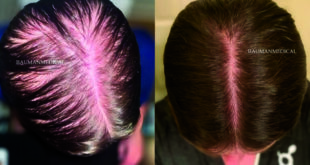By Lauren R. Rosecan, M.D., Ph.D., F.A.C.S.
Macular telangiectasia is a disease affecting the macula, causing loss of central vision. The macula is a small area in the retina the light-sensitive tissue lining the back of the eye that is responsible for your central vision, allowing you to see fine details clearly.
Macular telangiectasia develops when there are problems with the tiny blood vessels around the fovea, the center of the macula. There are two types of macular telangiectasia, and each affects the blood vessels differently.
Type 2 macular telangiectasia
The most common form of macular telangiectasia is Type 2 macular telangiectasia, in which the tiny blood vessels around the fovea leak, become dilated (widen), or both. In some cases, new blood vessels form under the retina and they can also break or leak. Fluid from leaking blood vessels causes the macula to swell or thicken, a condition called macular edema, which affects your central vision. Also, scar tissue can sometimes form over the macula and the fovea, causing loss of detail vision. Type 2 affects both eyes but not necessarily with the same severity.
Type 1 macular telangiectasia
In Type 1 macular telangiectasia, the blood vessels become dilated forming tiny aneurysms, causing swelling and damaging macular cells. The disease almost always occurs in one eye, which differentiates it from Type 2.
Macular Telangiectasia Symptoms
In the early stages, people with macular telangiectasia will have no symptoms. As the disease progresses, you may have such symptoms as blurring, distorted vision, and loss of central vision. You may need brighter light to read or perform other functions. Loss of central vision progresses over a period of 10 to 20 years. Macular telangiectasia does not affect side vision and does not usually cause total blindness.
Because macular telangiectasia has no symptoms in the early stages, it is very important to get regular eye exams from an ophthalmologist (Eye M.D.) to detect any macular problems as early as possible.
Who Is At Risk for Macular Telangiectasia?
Type 2 macular telangiectasia occurs primarily in middle-aged adults. Both men and women are equally affected. If you have a systemic disease such as diabetes or hypertension, you may be at increased risk for getting macular telangiectasia. The disease seems to run in some families so there may be a genetic predisposition but this is not yet completely understood. However, in most cases, there is no known cause for the disease if found.
Type 1 macular telangiectasia is associated with Coat’s disease, a rare congenital eye disorder diagnosed in childhood, and is found almost entirely in males. Type 1 macular telangiectasia diagnosis is usually made around age 40.
Macular Telangiectasia Diagnosis
First, your eye doctor will perform a thorough assessment of your vision including testing with an Amsler grid to detect any wavy or dark areas in your central vision. The doctor will then dilate (widen) your pupils using eyedrops and examine your eyes with an ophthalmoscope, a device that allows him or her to see the retina and other areas at the back of the eye.
If your ophthalmologist suspects you have macular telangiectasia, he or she usually will take special photographs of your eye with optical coherence tomography (OCT) and fluorescein angiography.
OCT scanning uses light waves to create detailed images of the underlying structure of the retina. OCT images show the thickness of the retina, and can help your Eye M.D. detect swelling and abnormal blood vessels.
During fluorescein angiography, a vegetable-based dye is injected into a vein in your arm. The dye travels throughout the body, including your eyes. Photographs are taken of the back of your eye as the dye passes through the retinal blood vessels. Abnormal areas will be highlighted by the dye. Fluorescein angiography is often repeated periodically, especially if vision is worsening.
Macular Telangiectasia Treatment
Over the years, a number of macular telangiectasia treatments have been studied but none have proven to significantly improve vision. However, since the disease has a relatively good prognosis, most patients may not require treatment.
In certain cases, laser treatments may be used to help seal leaking vessels but this is less preferred because of potential harmful secondary effects. In other instances, medication injections such as steroids or other medication may be used.
One serious complication of macular telangiectasia is the development of abnormal blood vessels under the retina. This is called choroidal neovascularization, and may call for injections of a drug called vascular endothelial growth factor inhibitors (anti-VEGF). Anti-VEGF medication targets a specific chemical in your eye that causes abnormal blood vessels to grow under the retina. That chemical is called vascular endothelial growth factor, or VEGF. Blocking VEGF with medication injections reduces the growth of abnormal blood vessels, slows their leakage, helps to reduce swelling of the retina, and in some cases may improve vision.
Unfortunately, sometimes treatment does not appear to offer much benefit. Clinical studies are underway to better understand the disease and identify potential useful treatments.
People who have vision loss from macular telangiectasia may find that low vision aids can help them make the most of their remaining vision.
Lauren R. Rosecan
M.D., Ph.D., F.A.C.S.
The Retina Institute of Florida with four offices
conveniently located in Palm Beach and Martin Counties.
Toll Free Phone Number:
1-800-445-8898 561-832-4411
West Palm Beach
901 North Flagler Drive, 33401.
(561) 832-4411 Office. (561) 832-1591 Fax
Palm Beach Gardens
11382 Prosperity Farms Rd., #128, 33410.
(561) 627-7311 Office. (561) 627-6791 Fax
Stuart 618 East Ocean Blvd., #3, 34994.
(772) 287-7026 Office. (772) 220-4186 Fax
Boca Raton 1050 NW 15th Street, #114, 33486.
(561) 368-7723 Office. (561) 368-0093 Fax
Check Also
WHAT IS MY CIRCADIAN RHYTHM AND WHY DOES IT MAKE ME FEEL SO “OFF”
By Renee Chillcott, LMHC Have you heard terms such as “biological clock” or “biorhythms”, or …
 South Florida Health and Wellness Magazine Health and Wellness Articles
South Florida Health and Wellness Magazine Health and Wellness Articles




